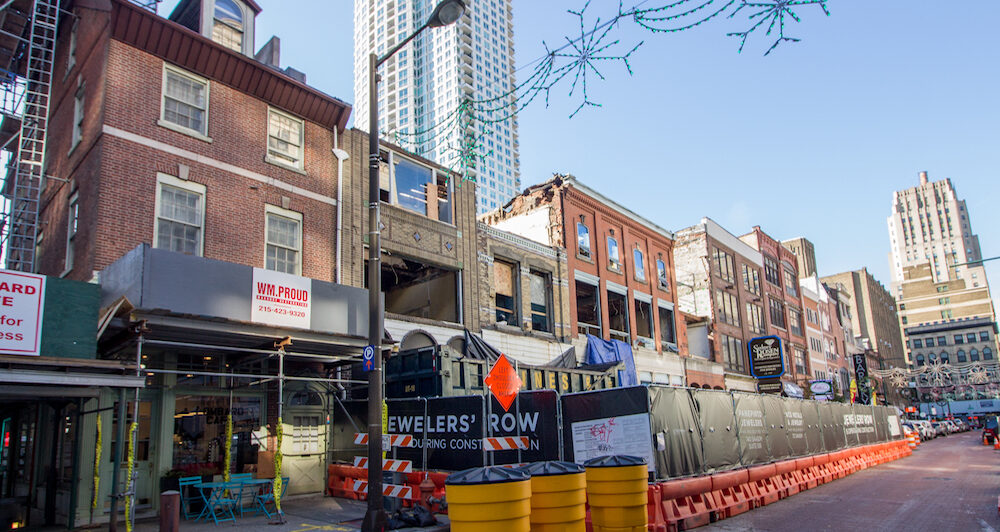By Paul Steinke & Patrick Grossi
December 15, 2022
In August 2016, word spread that a demolition notice had appeared on Philadelphia’s historic Jewelers Row, the second-largest jewelry district in the nation – and by some estimates, the nation’s oldest. We at the Preservation Alliance were incredulous and outraged. How could this be happening on Jewelers Row, one of the most intact and architecturally distinctive commercial blocks in the city, a magnet for locals and tourists alike? But to our shock and dismay, there it was: a big orange sticker declaring that four buildings – 702, 704, 706-08 and 710 Sansom Street – dating as far back as 1865 and occupied by functioning jewelry businesses, were slated for the wrecking ball. Toll Brothers, a high profile housing developer from nearby Horsham, PA, had quietly assembled a parcel on which they proposed a shiny new, condo tower totally out of scale with the surrounding low-rise historic buildings.
That’s when we took the saying, “Never waste a good crisis”, to heart. In the end, we lost the battle to save that chunk of Jewelers Row. But the public outcry generated by the destruction helped lead to important reforms in Philadelphia’s municipal development policies. To be sure, the loss of irreplaceable historic structures didn’t end with Jewelers Row. Painful demolitions since then include Our Lady of the Rosary Church at 63rd & Callowhill, the home of artist Joseph Pearson in Germantown and the 12th Street Gym complex in Washington Square West. Nevertheless, preservation policy reforms enacted since then are at last beginning to pay off.

As evidence, the website Rent Café recently reported that, in 2020 and ’21, Philadelphia was #2 in the nation in the conversion of old buildings to apartments, surpassed only by Washington, D.C. New zoning incentives for historically designated properties passed by City Council in 2020 are starting to have an impact: according to the Philadelphia Historical Commission, almost two dozen historic properties have taken advantage of the new zoning, parking, and accessory dwelling allowances. In addition, the city’s 10-year tax abatement was scaled back for new, residential construction starting in 2022 but remains in full force for the rehabilitation of existing buildings, amounting to the city’s first real financial incentive for historic preservation in at least two decades. Alas, these reforms all came too late to prevent the Jewelers Row debacle, but they point to a better future for our city.
In addition, neighborhood advocates, alarmed to see their historic built environments come under assault during the last decade’s construction boom, have led the way. Recent examples include the creation of new local historic districts on Christian Street/Black Doctors Row, in Powelton Village, and in Victorian Roxborough.
It is vitally important that Philadelphia build on this progress under the next Mayor and City Council. In the more than three centuries since its founding, Philadelphia has played a crucial role in every era of American history. Our vast building stock reflects that historic significance. Nearly 70% of Philadelphia’s buildings were built before 1945, and the city is replete with architectural and historic landmarks, streetscapes, and neighborhoods that should be the envy of urban centers around the world. If the city is to remain a choice destination to live, work, and raise a family, our neighborhoods need and deserve historic protections and investment to strengthen their vitality and appeal.
Here is our wish list for the city’s next generation of leadership:
- Adequately Fund the Philadelphia Historical Commission
Despite modest increases in staff size under the Kenney administration, the funding and staffing levels of the Philadelphia Historical Commission (PHC) remain insufficient. The Commission operates with a budget under $1 million, an allocation that compares unfavorably with most of our urban peers. In this most historic of American cities, home to more than 500,000 buildings, the PHC relies on the dedicated work of merely nine staffers (only seven of which are preservation planners handling day-to-day business).
The creation of new local historic districts, including those named above, have added greatly to the PHC’s daily workload and only further reiterate the need for increased staff capacity. Furthermore, the PHC would be the appropriate agency to manage the proposed, and essential, Citywide Survey of Historic and Cultural Resources (see below). If Philadelphia is to have a nimble, modern, and efficient Historical Commission, it must be adequately funded and enabled to fully pursue its mission as outlined in the City’s Preservation Ordinance. - Implement Partial Control Districts
A current barrier to historic designation of individual properties and/or inclusion in a local historic district is the perceived burden for property owners. Some owners are reluctant to acquiesce to what they view as onerous guidelines on maintenance and alterations and their associated costs. A Partial (or “Soft”) Control District would address those concerns, focusing primarily on the preservation of scale and historic character, while still regulating demolition and new construction. Such districts would more readily accept modern replacement materials (windows, doors, roofing, etc.).
Our existing Neighborhood Conservation Overlay Districts already exemplify this approach, but they only partially regulate “speculative” demolition and are primarily intended to guide the design of new, infill development.
Creating a new, more flexible form of historic district was among the key recommendations of the Historic Preservation Task Force. The Department of Planning and Development and PHC have both endorsed the idea in concept. A more flexible historic district also has promise to better recognize communities less defined by high-style architecture and more noteworthy for consistency of scale, building type and cultural heritage. - Strengthen Municipal Incentives for Historic Preservation
There are currently few economic or procedural incentives for the preservation and rehabilitation of historic properties in Philadelphia. The most popular and effective program is the Federal Historic Rehabilitation Tax Credit. Buildings eligible for that program must be “income-producing” and listed (or deemed eligible for inclusion) on the National Register of Historic Places (NRHP). Pennsylvania offers a similar, though less generous, state tax credit as well. Both programs are typically most advantageous to developer or institution-driven, large-scale projects (though federal legislation is under consideration to make the program more accessible to smaller scale operators).
The City of Baltimore, by contrast, administers a mirror of these programs at the municipal level, offering a ten-year tax credit for both homeowners and commercial property owners within the city’s 70+ historic districts. Existing properties in Philadelphia, historically designated or otherwise, are currently eligible for the city’s ten- year tax abatement. But the abatement is limited to the cost of “improvements,” a benefit which typically pales in comparison to the much greater abatement afforded to new construction projects. Even with the recent amendments to the abatement, which curtail abatements for new construction, rehab projects are often misperceived as unwieldy or excessively costly. Adjusting the basis of the rehabilitation abatement (such that very extensive rehabilitations effectively reduce the base value of the property to zero – and render the entire project an “improvement”) may be a further corrective to this.
The City of Philadelphia did adopt three procedural incentives in early 2020, each of which were key recommendations of the Historic Preservation Task Force. They include Use Zoning Relief, Parking Minimum Relief, and the allowance of Accessory Dwelling Units (ADUs). These provisions are limited to buildings listed on the Philadelphia Register of Historic Places, and likewise must meet certain square footage and historic use thresholds.
Whatever the path, direct monetary assistance to owner occupants of historic homes (particularly low-to-middle income households) and owner operators of small businesses is most sorely needed. Reduced tax assessments, homeowner repair grants, and/or low-interest loans are the most effective means. Also, augmenting existing programs to prioritize or more highly reward historic properties (i.e., Restore, Repair, Renew; Basic Systems Repair Program; Weatherization Assistance Program; Storefront Improvement Program, and the newly created Whole Home Repairs program) would be a simple approach with high impact. - Complete the Citywide Survey of Historic and Cultural Resources / “Tell the Full Story”
In summer 2022, the Department of Planning and Development and PHC launched a pilot Cultural Resource Survey. PHC has also adopted GIS software to facilitate future survey work. Much of this effort is being made possible by a grant from the William Penn Foundation
The city has never conducted a comprehensive citywide survey of historic resources, an essential document that would help guide future development initiatives and preservation best practices. By providing a clear and thorough assessment of the city’s historic properties, we can ensure that the buildings and spaces we cherish stand proudly alongside the welcome new developments throughout Philadelphia.
Though the preservation community has been clamoring for such a survey for over three decades, the need has never been greater. A Cultural Resource survey will ensure that properties reflecting the city’s diverse heritage will be appropriately recognized, with increased emphasis on the places and spaces that tell the broad history of nonwhite Philadelphians. - Building Reuse is Climate Action
Since at least the 1970s preservationists have argued for the environmental and energy-
saving benefits of preserving historic places. In 2007, Maryland architect Carl Elefante distilled this idea into a now much-quoted mantra: “The greenest building is one that is already built.” As the city contends with the dramatic and ongoing effects of climate change, historic preservation and intentional building reuse are necessary components of any sensible and holistic approach.
The demolition of existing buildings and subsequent construction of new buildings not only contributes greatly to energy consumption and an ever-growing waste stream, it also discards decades of “embodied energy,” the extracted material, labor and finite resources invested in that building’s original construction.
Multiple reports, from respected organizations like the National Trust for Historic Preservation and independent organizations associated with the architecture and building trades, have concluded that building reuse, paired with modernized energy efficiency performance, produces the lowest carbon footprint relative to new construction.
We preserve buildings to honor our collective past, to recognize architectural achievement, to sensibly manage change. But we must also begin to more forcefully recognize the material, environmental benefit of preserving old places and the ways in which they can help forestall the dramatic and disruptive impacts of a changing climate. - Existing Housing is Affordable Housing
Similar to the above credo regarding our “greenest buildings,” housing advocates often contend that the most affordable home is the one someone already lives in. In tandem with the above recommendations for direct homeowner assistance, helping owner occupants and small landlords maintain their aging properties allows families and individuals to age in place, avoid the hardships and disruptions of an unexpected move, bolsters public health, and helps preserve what is recognized as Naturally Occurring Affordable Housing (NOAH).
The city’s vast supply of vacant and underutilized historic properties further provides opportunities for newly created affordable housing, whether via rehabilitated rowhouses or larger structures that can accommodate multi-family developments. Former schools, in particular, have proved particularly adaptable as affordable housing options within a historic setting, such as Project Home’s Maguire Residences in a 1907 former elementary school in Kensington.
Some trace the beginning of the modern preservation movement to the demolition of Penn Station in New York City in the early 1960s. Perhaps historians will look back at the losses on Jewelers Row in the Twenty Teens as the moment that the tides changed for historic preservation in Philadelphia. After all, we hold title to the claim of America’s most historic big city. It’s about time we started acting like it.
